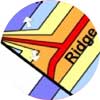 |
Atypical post-breakup magmatism along
the Jan Mayen Fracture Zone: Do we need a mantle plume?
|
Laurent
Gernigon1, Odleiv
Olesen1,
Carmen
Gaina1 & Susann
Wienecke2
1 Geological
Survey of Norway (NGU), Trondheim, Laurent.Gernigon@ngu.no ; Odleiv.Olesen@ngu.no ; Carmen.Gaina@ngu.no
2 StatoilHydro,
Trondheim, suw@statoilhydro.com
1. Introduction
The Norwegian-Greenland Sea began
to open when Norway and Greenland separated in the
Early Tertiary (Figure 1). This major tectonic event
was accompanied by a significant and well-known magmatic
event (see Meyer et al., 2007 for a recent
review). Large uncertainties still remain about the
actual amount of melt formed during the breakup (Gernigon
et al., 2004; see also Norwegian
Volcanic Margin page).
Some authors have argued that the “voluminous” breakup
magmatism may reflect compositional heterogeneities
and/or plate-driven dynamic processes in the upper
mantle and not necessarily excess mantle temperature
associated with a deep mantle plume (van
Wijk et al., 2001; Foulger,
2007; Gernigon et al., 2006; Korenaga,
2004; see also Decompressional
Melting During Extension of Continental Lithosphere).
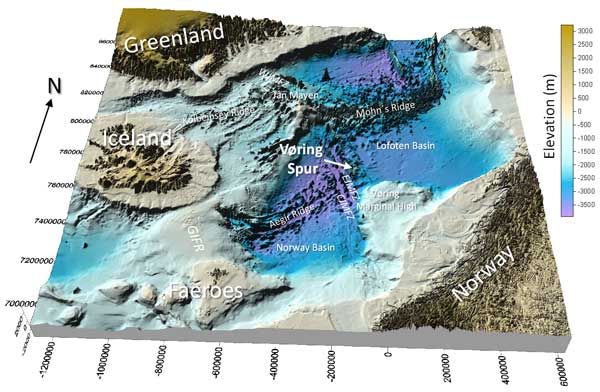
Figure 1: Bathymetric map and
main physiographic features of the Norwegian-Greenland
Sea. The Jan Mayen Fault Zone (JMFZ), which separates
the Lofoten Basin from the Norway Basin in the south
consists of three distinct segments, the western
(WJMFZ), eastern (EJMFZ) and central Jan Mayen Fracture
zones (CJMFZ), respectively. The JMFZ is almost sub-parallel
to the Greenland-Iceland-Faroes Ridge (GIFR). Click
here or on Figure for enlargement.
Recent contributions have asked
challenging questions about the timing, variability
and origin of the atypical magmatic events that affected
the Norwegian-Greenland Sea after the breakup phase
(Breivik et al., 2006; Greenhalgh & Kusznir,
2007; Olesen et al., 2007; Breivik
et al., 2008). These contributions
concur that a clear understanding of the tectonic
and magmatic history of the Norwegian oceanic domain
is essential when dealing with breakup, spreading
rate evolution, intraplate magmatism and the influence
of deep but controversial sub-lithospheric processes
that may or may not involve an Icelandic mantle plume.
The main objective of the present
work is to re-examine the geophysical and tectonic
setting of the Norwegian-Greenland Sea in the vicinity
of the Jan Mayen Fracture Zone (JMFZ), west of the
Vøring
Marginal High, that significantly affected breakup
magmatism (Figure 1). Changes in plate stress
configuration, seen in the fabric of the oceanic
crust, clearly influence the location of atypical
magmatic features.
2. The Vøring
Spur (VS): an intriguing oceanic feature in the Norwegian
Greenland Sea
The Vøring Spur (VS) is a
remarkable bathymetric high located along the trend
of the JMFZ (Figures 1, 2 & 3). A recent high-resolution
magnetic survey (Gernigon et al.,
2009)
suggests that it is an atypical
oceanic feature (Figure 2B).
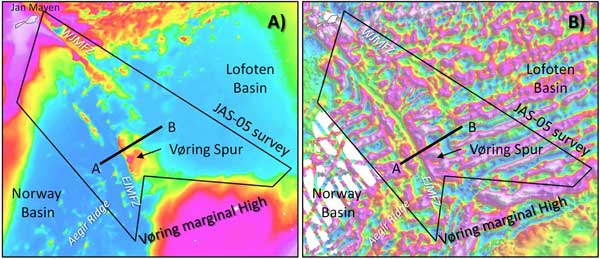
Figure 2: A) Bathymetry near
the Vøring Spur. B) New JAS-05 aeromagnetic
survey between the Vøring Marginal High
and Jan Mayen island (Gernigon
et al., 2009).
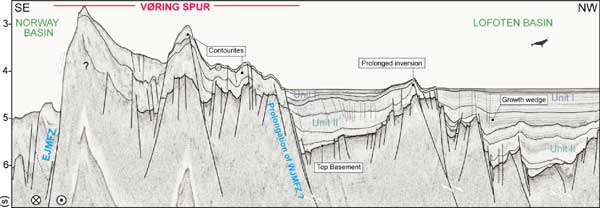
Figure 3: Profile AB across
the Vøring Spur. This section illustrates
the seismic and structural characteristics of the
VS located between the EJMFZ and the prolongation
of the WJMFZ (section NPD modified after Gernigon
et al., 2009). Location is shown in Figure 2. Click
here or on figure for enlargement.
The VS displays a negative gravity
anomaly. 3D isostatic modelling suggests the presence
of a deep crustal root and local compensation (Figure
4). The thick oceanic crust of the VS (16-17 km) is
surprising, as typical oceanic crust usually does not
exceed 7-10 km in thickness. The thickening of the
crust is similar to a lower crustal body modelled
beneath the Vøring Marginal High (e.g.,
Mjelde et al., 2007, Breivik
et al., 2008).
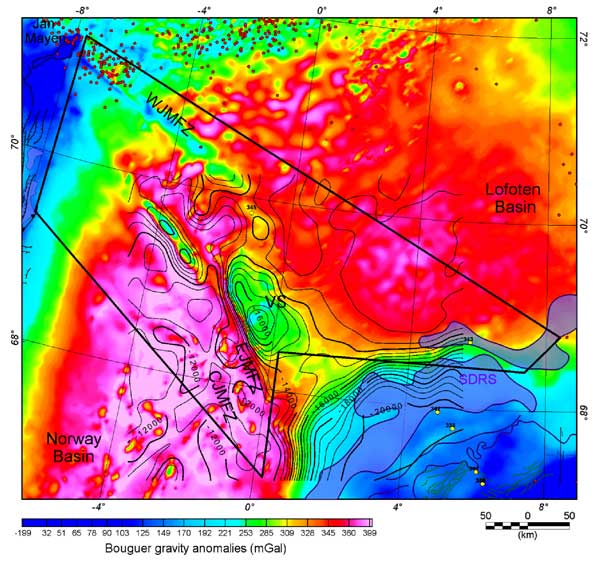
Figure
4: Bouguer anomaly map of the eastern
Norwegian Greenland Sea combined with depth contours
of the Moho estimated using the ASEP algorithm of
Wienecke et al. (2007). The
Vøring Spur (VS) is characterised by an apparent
Bouguer low and thick oceanic crust, contrasting
with surrounding oceanic regions. SDRS: seaward dipping
reflector basaltic sequences emplaced along the continent-ocean
transition.
The existence of thick oceanic crust
below the VS is evidence that anomalous melt
production still persisted after the breakup of the
Mid-Norwegian volcanic margin. Two explanations for
this have been published recently:
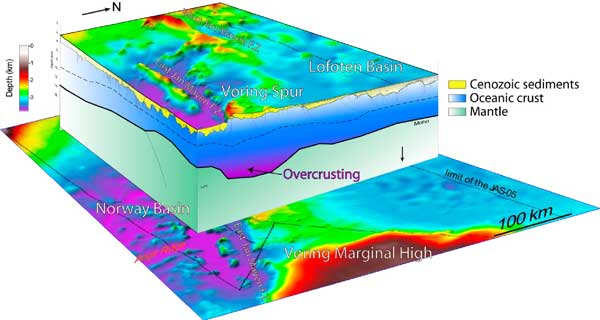
Figure 5: 3D crustal structure
of the Vøring
Spur. The oceanic root, observed beneath the
VS, is interpreted as an oceanic, syn-rift, mafic
feature formed during the Eocene. To
avoid confusion with the Late Miocene underplating
hypothesis we use the term "overcrusting" to
signify anomalous but syn-spreading
magmatic production.
3. Tectonic model for the origin and evolution
of the VS
We propose that overcrusting could
have occurred along the JMFZ crust
in the Eocene. Breivik et al. (2008)
suggested that partially molten mantle from the lowest
part of the melt column was produced under the
Aegir Ridge and captured by asthenospheric flow
from a plume under Iceland, before surfacing
northeast of the EJMFZ in the Miocene. This model requires
that the asthenosphere retain a molten component
for a long time (10-15 Ma), but
the reason for such a temporal delay in extracting
the melt is unclear. Most of the sedimentary
sequences near the VS are not
affected by significant intrusions (Figure 3).
This is inconsistent with a major Late Miocene
magmatic event.
We propose instead that the VS is
a volcanic edifice formed during the Eocene and we
suggest genetic kinematic control of the JMFZ on
the melt production and distribution since breakup
time. Also, magmatism is still active and
anomalous along the trend of the JMFZ as shown by
the stratovolcano Beerenberg on Jan
Mayen island (Figure 2).
Plate reconstruction
(Figure 6) shows that during the Eocene the VS was
located between the Vøring
Marginal High and the Traill igneous complex, located
now offshore Greenland (e.g.
Olesen et al., 2007).
Gernigon et al. (2009) propose that the
Traill igneous complex were genetically associated
with the Vøring
Marginal High convex volcanic rift system in a kind
of triple junction initiated during the early stage
of oceanic spreading. The distribution of the anomalous
magmatism, observed at the VS, is explained
by a leaky transform or oblique crack developing
along the JMFZ.
Lithospheric weakening and thinning
may have subsequently resulted in local upwelling and
decompression melting of the upper mantle under
the VS. Melt developed preferentially near
the oceanic transform, which also created a major pathway
for magma to reach the surface.
The VS or the Traill igneous complex
could have behaved, at some stage, as a leaky transform
axis, similar to the Terceira "rift" in
the Azores Plateau (Searle, 1980; Vogt
& Jung, 2004). Like the VS, its origin
is still uncertain and a deep mantle plume influence
is debatable (Bonatti, 1990; Yang
et al., 2006).
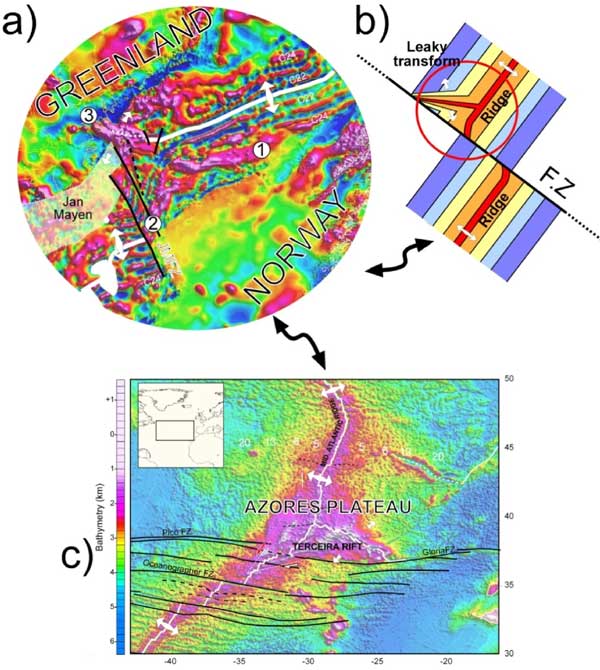
Figure 6: a) Plate reconstruction
of Greenland and Norway at C21 (~47 Ma ). This figure
illustrates a triple junction between three magnetic
(and magmatic) branches: (1) and (2) coincide with
the location of SDR wedges along theVøring
Marginal High and (3) with the Greenlandic part of
the Traill igneous complex. b) A leaky transform
model (e.g., Searle, 1980) can be proposed for both
and the Traill igneous complex lying in the trend
of the VS could have formed obliquely along the trend
of the pre-existing EJMFZ. c) The Azores Plateau
can be used as a modern analogue to the Jan Mayen
spreading system. The situation is similar;
a triple junction and volcanic traps formed along
the spreading ridge and seem to be influenced
by the pre-existing oceanic fracture zones. A third
branch (the Terceira Rift) propagates in transtension
and/or as a slowly extending rift from the spreading
ridge toward the adjacent oceanic fracture zones.
4. Anomalous post-breakup magmatism
along the Jan Mayen Fracture Zone: do we need a mantle
plume?
Whether a plume influenced the opening
of North Atlantic is still a matter of debate. Here
we show that simple tectonic plate dynamics or mantle
composition heterogeneities may have enhanced melt
production and produced the VS.
Complex lithospheric stresses along
the JMFZ can explain outbursts of magmatic activity
observed along the oceanic fracture zone. Brittle weakening
of the lithosphere and development of a leaky transform
could explain enhanced magmatism along the JMFZ.
Many authors have shown that plate boundaries
such as transform faults can channel magma to the
surface and they also document the prevalence of
"coincidental" relationships
between supposed hotspot features and pre-existing
weakness zones (Beutel, 2005; see also South
Atlantic page).
Behn et al. (2007) have
also shown that a rheology that incorporates brittle
weakening of the lithosphere along the fracture zone
can explain regions of enhanced mantle upwelling and
elevated temperatures under a transform. Huang
et al. (2003) also
provided numerical evidence that small-scale convection
can develop beneath the oceanic transform itself.
The Greenland-Iceland-Faroes Ridge,
initiated since the time of breakup, is surprisingly
parallel to the JMFZ and also represents another example
of anomalously thick oceanic crust (~ 30 km; Smallwood
et al., 1999). Some
authors have claimed that the Greenland-Iceland-Faroes
Ridge is simply the result of decompression of "cold"
melt-prone mantle materials influenced by the imprint
of old Caledonian structures ( Foulger
et al., 2005; see also Iceland
& the North Atlantic Igneous Province).
A similar scenario cannot be totally excluded along
the JMFZ. Occurrence and local upwelling of melt-prone
mantle material could have favoured higher magmatic
production along the trend of the JMFZ. Most fundamentally,
these, and other models (see also The
Iceland “Anomaly” – An Outcome
of Plate Tectonics and Origin
of the Iceland hotspot and the North Atlantic Igneous
Province) do not necessarily
involve the influence of deep mantle plumes. 5. Summary
-
The VS is an anomalous
oceanic high lying north of the EJMFZ. The structure
and the low Bouguer gravity signature of the VS
can be explained by thick oceanic crust, which
locally reaches 15 km. We propose that this thick
oceanic crust formed by overcrusting, syn-accretion–during
the Eocene–and not necessarily during the Miocene
as previously proposed.
-
The large melt
production that initiated along the Vøring
Marginal High during breakup continued episodically
along the trend of the JMFZ. The local increase
of magma production along the JMFZ suggests that
the oceanic transform acted, and still acts, as
a long-lived magmatic pathway for melts in the
lithosphere.
-
Plate
reconstruction suggests that a triple junction,
similar to the Azores Plateau system, could have
initiated slightly after breakup between
the Vøring
Marginal High, the VS and the Traill igneous complex,
now located offshore Greenland. Volcanic activity
may have increased locally along a leaky transform
acting as the third branch of the junction, slightly
oblique to the pre-existing EJMFZ.
-
This webpage illustrates the
importance of oceanic fracture zones in melt
production. Processes involved along the JMFZ might
provide clues to help understand the evolution
of further oceanic controversial features, such
as the Greenland-Iceland-Faeroes Ridge, or simply
to understand better the processes involved during
the breakup of the Mid-Norwegian volcanic margin.
Nevertheless, more work needs to be carried out
and future data acquisition is required
to solve the complex magmato-tectonic puzzle of
the Norwegian-Greenland Sea and the meaning of
the Icelandic “anomaly”.
Acknowledgments
This paper
summarises part of the recent paper Gernigon,
L., Olesen, O., Ebbing, J., Wienecke, S., Gaina, C.,
Mogaard, J.O., Sand, M. & Myklebust, R. 2009: Geophysical
insights and early spreading history in the vicinity
of the Jan Mayen Fracture Zone, Norwegian-Greenland
Sea. Tectonophysics, 468 185-205.
The Norwegian Petroleum Directorate kindly provided
seismic, high-resolution bathymetric data from the
Jan Mayen-Vøring
area. The grid rotation program developed by M.
Smethurst was used for the plate reconstruction.
We acknowledge the invitation of Gillian Foulger
to present a summary of our paper in this webpage.
References
-
Behn,
M.D., Boettcher, M.S. and Hirth, G., 2007. Thermal
structure of oceanic transform faults. Geology, 35:
307-310.
-
Beutel,
E.K., 2005. Stress-induced seamount formation at
ridge-transform intersections. In: G.R. Foulger,
J.H. Natland, D.C. Presnall and D.L. Anderson (Editors), Plates, Plumes, and Paradigms. Geological Society of America Special Paper 338,
pp. 581-593.
-
Bonatti,
E., 1990. Not so hot "hot spots" in the
oceanic mantle. Science, 250: 107-111.
-
Breivik,
A., Faleide, J.I. and Mjelde, R., 2008. Neogene
magmatism northeast of the Aegir and Kolbeinsey
ridges, NE Atlantic: Spreading ridge mantle plume
interaction? Geochemistry Geophysics Geosystems, 9: Q02004, doi:10.1029/2007GC001750.
-
Breivik,
A.J., Mjelde, R., Faleide, J.I. and Murai, Y.,
2006. Rates of continental breakup magmatism and seafloor
spreading in the Norway Basin-Iceland plume interaction. Journal of Geophysical Research, 111: B07102, doi:10.1029/2005JB004004.
-
Foulger,
G.R., 2007. The "Plate" model for the
geneis of melting anomalies. In: G.R. Foulger and
D.M. Jurdy (Editors), Plates,
Plumes, and Planetary Processes.
Geological Society of America, Special paper 430.
-
Foulger,
G.R., Natland, H. and Anderson, L., 2005. A source
for Icelandic magmas in remelted Iapetus crust. Journal
of Volcanology and Geothermal Research, 141: 23-44.
-
Gernigon,
L., Olesen, O., Ebbing, J., Wienecke, S., Gaina,
C., Mogaard, J.O., Sand, M. and Myklebust, R., 2009.
Geophysical insights and early spreading history
in the vicinity of the Jan Mayen Fracture Zone, Norwegian-Greenland
Sea. Tectonophysics, 468 185-205.
-
Gernigon,
L., Lucazeau, F., Brigaud, F., Ringenbach, J.C.,
Planke, S. and Le Gall, B., 2006. A moderate melting
model for the Voring margin (Norway) based on structural
observations and a thermo-kinematical modelling:
Implication for the meaning of the lower crustal
bodies. Tectonophysics, 412: 255-278.
-
Gernigon,
L., Ringenbach, J.C., Planke, S. and Le Gall, B.,
2004. Deep structures and breakup along volcanic
rifted margins: Insights from integrated studies
along the outer Vøring Basin (Norway). Marine
and Petroleum Geology, 21: 363-372.
-
Greenhalgh,
E.E. and Kusznir, N.J., 2007. Evidence for thin
oceanic crust on the extinct Aegir Ridge, Norwegian
Basin, NE Atlantic derived from satellite gravity
inversion. Geophysical Research Letters, 34: L06305, doi:10.1029/2007GL029440.
-
Huang,
J., Zhong, S. and van Hunen, J., 2003. Controls
on sublithospheric small-scale convection. Journal of Geophysical Research, 108, 2405: doi:10.1029/2003JB002456.
-
Korenaga,
J., 2004. Mantle mixing and continental breakup
magmatism. Earth and Planetary
Science Letters, 218:
463-473.
-
Meyer,
R., van Wijk, J.W. and Gernigon, L., 2007. An integrated
geophysical and geochemical model for North Atlantic
Igneous Province magmatism. In: G.R. Foulger and
D.M. Jurdy (Editors), Plates,
Plumes, and Planetary Processes. Geological Society of America Special
Paper 430, pp. 525-552.
-
Mjelde,
R., Raum, T., Murai, Y. and Takanami, T., 2007.
Continent-ocean-transitions: Review, and a new
tectono-magmatic model of the Vøring Plateau,
NE Atlantic. Journal of Geodynamics, 43: 374-392.
-
Olesen,
O., Ebbing, J., Lundin, E., Mauring, E., Skilbrei,
J.R., Torsvik, T.H., Hansen, E.K., Henningsen,
T., Midbøe, P. and Sand, M., 2007. An improved tectonic model for the Eocene
opening of the Norwegian-Greenland Sea: Use of
modern magnetic data. Marine and Petroleum Geology, 24: 53-66.
-
Searle,
R.C., 1980. Tectonic pattern of the Azores spreading
centre and triple junction. Earth
and Planetary Science Letters, 51:
415-434.
-
van
Wijk, J.W., Huismans, R.S., ter Voorde, M. and
Cloetingh, S., 2001. Melt generation at volcanic
continental margins: no need for a mantle plume? Geophysical Research Letters, 28: 3995-3998.
-
Vogt,
P.R. and Jung, W.Y., 2004. The Terceira Rift as
hyper-slow, hotspot-dominated oblique spreading
axis: A comparison with other slow-spreading plate
boundaries. Earth and Planetary Science Letters, 218: 77-90.
-
Wienecke,
S., Braitenberg, C. and Götze, H.J., 2007.
A new analytical solution estimating the flexural
rigidity in the Central Andes. Geophysical
Journal International, 169:
789-794.
-
Yang,
T., Shen, Y., van der Lee, S., Solomon, S.C. and
Hung, S.H., 2006. Upper mantle structure beneath
the Azores hotspot from finite-frequency seismic
tomography. Earth and Planetary Science Letters, 250: 11-26.
last updated 28th
April, 2009 |
